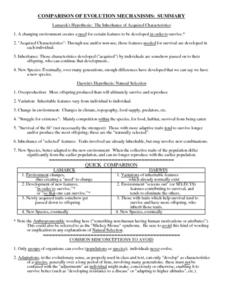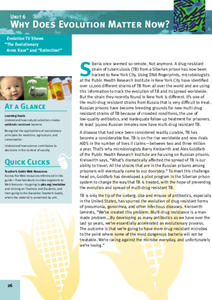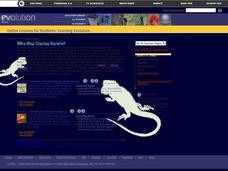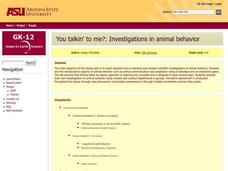Curated OER
The Great Jellybean Hunt
Students model natural selection by acting as predators of jellybeans. In this evolution lesson plan, students use plastic utensils to pick up jellybeans. They use different colors of backgrounds to demonstrate the effects of camouflage...
Curated OER
GED Vocabulary: Life Science
In this life science vocabulary worksheet, students complete a crossword puzzle using 10 given clues about various topics of life science such as natural selection, cell structures and function and components of the body systems....
Curated OER
Standard 4-Ecosystems
In this ecosystem worksheet, high schoolers answer questions about energy pyramids, food chains, consumers, producers, decomposers, biotic and abiotic factors in an environment, natural selection and the importance of biodiversity in an...
Curated OER
Relationships and Biodiversity Lab
In this relationships and biodiversity worksheet, students investigate the relationships between 4 plants sample using 7 different tests. These include looking at structural characteristics of the plants, seeds and stems, using paper...
Curated OER
Peppered Moth Simulation
Learners investigate the process of natural selection in peppered moths. In this natural selection lesson plan, students simulate peppered moths in environments similar to those during the industrial revolution. Learners use white paper...
Curated OER
Survival of the Sneakiest
In this natural selection worksheet, students read a cartoon about cricket mating that explains natural selection, fitness and evolution. They answer four questions about each of these topics.
Curated OER
Comparison of Evolution Mechanism
In this comparison of evolution worksheets, students read information about Lamarck's hypothesis of evolution and Darwin's hypothesis of evolution. Students then rate the scenarios given as either supportive of Lamarck's or Darwin's...
Curated OER
The Peppered Moth
In this evolution worksheet, students read about the changes the peppered moth went through over 100 year time period. Students complete 3 short answer questions based on what they read.
Curated OER
Why Does Evolution Matter Now?
Students examine how natural selection creates antibiotic-resistant bacteria,
recognize applications of evolutionary principles for medicine, agriculture, and conservation, and discuss how science contributes to decisions in context of...
Curated OER
Natural Selection
Students estimate how many different species of organisms inhabit the Earth. In groups, they match the pictures of embryos at the different stages of development. They compare and contrast animals from the sky, land, and water and...
Curated OER
Natural Selection Day 1
High schoolers define the concept of classification. In groups, they categorize a series of objects into categories they identify. As a class, they participate in a variety of activities to examine the concept of natural selection. To...
Curated OER
Beans and Birds: A Natural Selection Simulation
Young scholars solve the following problem concerning the evolution of seed color in pinto bean plants: "How does natural selection change the frequency of genes or traits over many generations?" They use the constructivist approach to...
Curated OER
Mimicry: An Example of Adaptation
Students are able to explain the relationship between adaptation and ability for survival and reproduction. They are able to give examples of a series of adaptations that would support the idea that evolution is a series of minor...
Curated OER
Why Do People Fall in Love?
Students discuss human behavior, sexual selection and the underlying genetic and evolutionary reasons for mate selection. The, in groups, they rate the attractiveness of certain individuals and measure facial features for symmetry.
Curated OER
Habitats and Adaptations
Students research and describe the habitat and adaptations of a reef animal. After the student is assigned a habitat, they design and draw a cresture adapted to eat each food and to live in each habitat.
Curated OER
Who Was Charles Darwin?
High schoolers complete two activities to study Charles Darwin's Theory of Natural Selection. They read Darwin's journal from the voyage of the Beagle and look at the scientific ideas that influenced the development of his theory.
Curated OER
How Does Evolution Work?
Students investigate how natural selection influences evolution. They complete a hands-on lab simulation of natural selection, and replicate a real experiment and examine the interplay between selection factors in a population of guppies.
Curated OER
You Talkin' To Me?: Investigations in Animal Behavior
Students investigate a variety of animal behaviors, examine various modes of animal communication, and develop a catalog analyzing, interpreting, and reporting their results.
Curated OER
The Creation of an Imaginary Species
Students explore the characteristics that distinguish different forms of animal life on Earth which are the results of natural selection and adaptations to their environment. The creatures are created using a game and then drawn by the...
Curated OER
The Chips Are Down: A Natural Selection Simulation
Students, in teams, use different colored paper chips to represent prey and a piece of fabric as the environment.
Curated OER
Natural Selection.... a Cumulative Process... it's in the cards!
Learners working in pairs attempt to produce a full sequence of 13 cards of one suit (ace - to king). This must be done by shuffling the suit of cards for each round, then checking the cards.
Curated OER
Lamarck And Darwin
Students compare Lamarck's mechanism for evolution with Darwin's theory of natural selection.
Curated OER
Preying on Beans
Students act as predators searching for prey (beans) in two different settings to demonstrate the processes of adaptation and selection.
Curated OER
The Rise and Fall of the Mammoths
Students develop an understanding of the evolution of species in the context of the woolly mammoth. They examine the fossil record to explain natural selection.

























